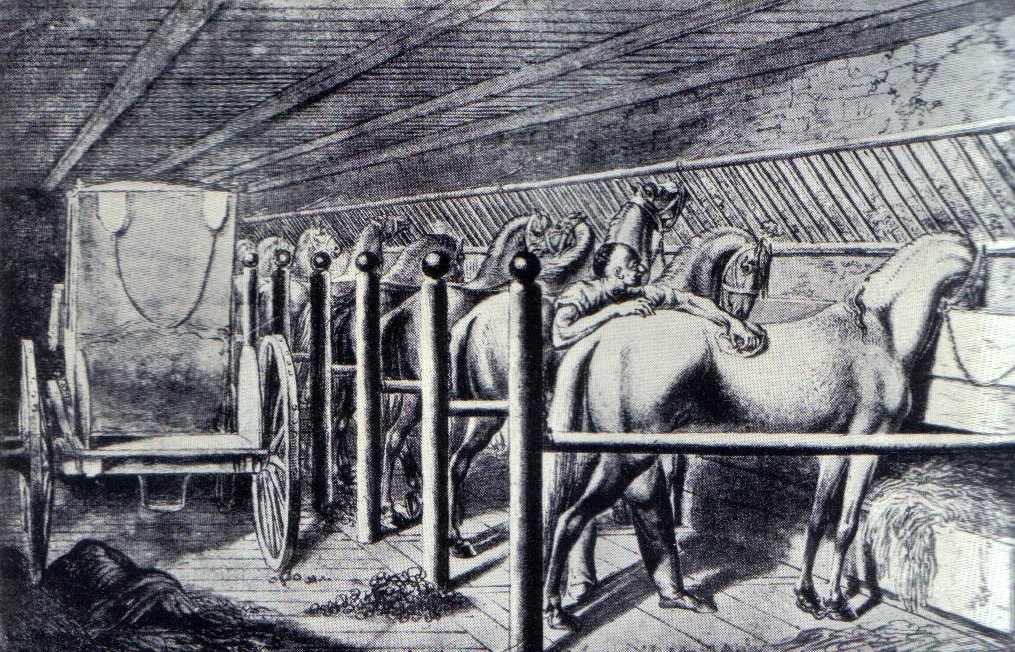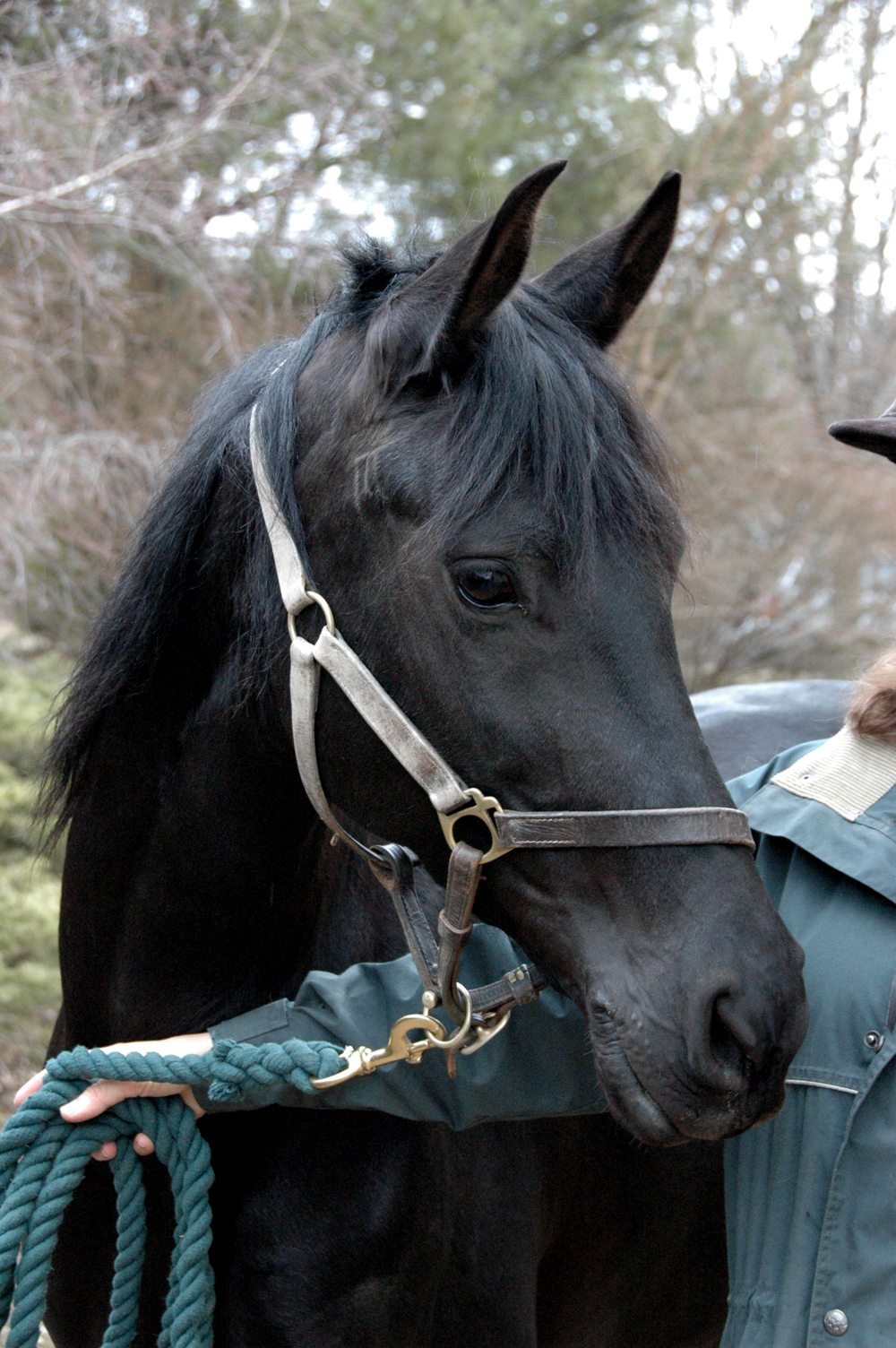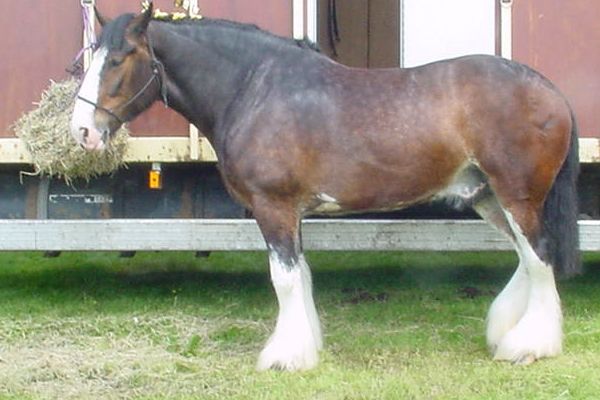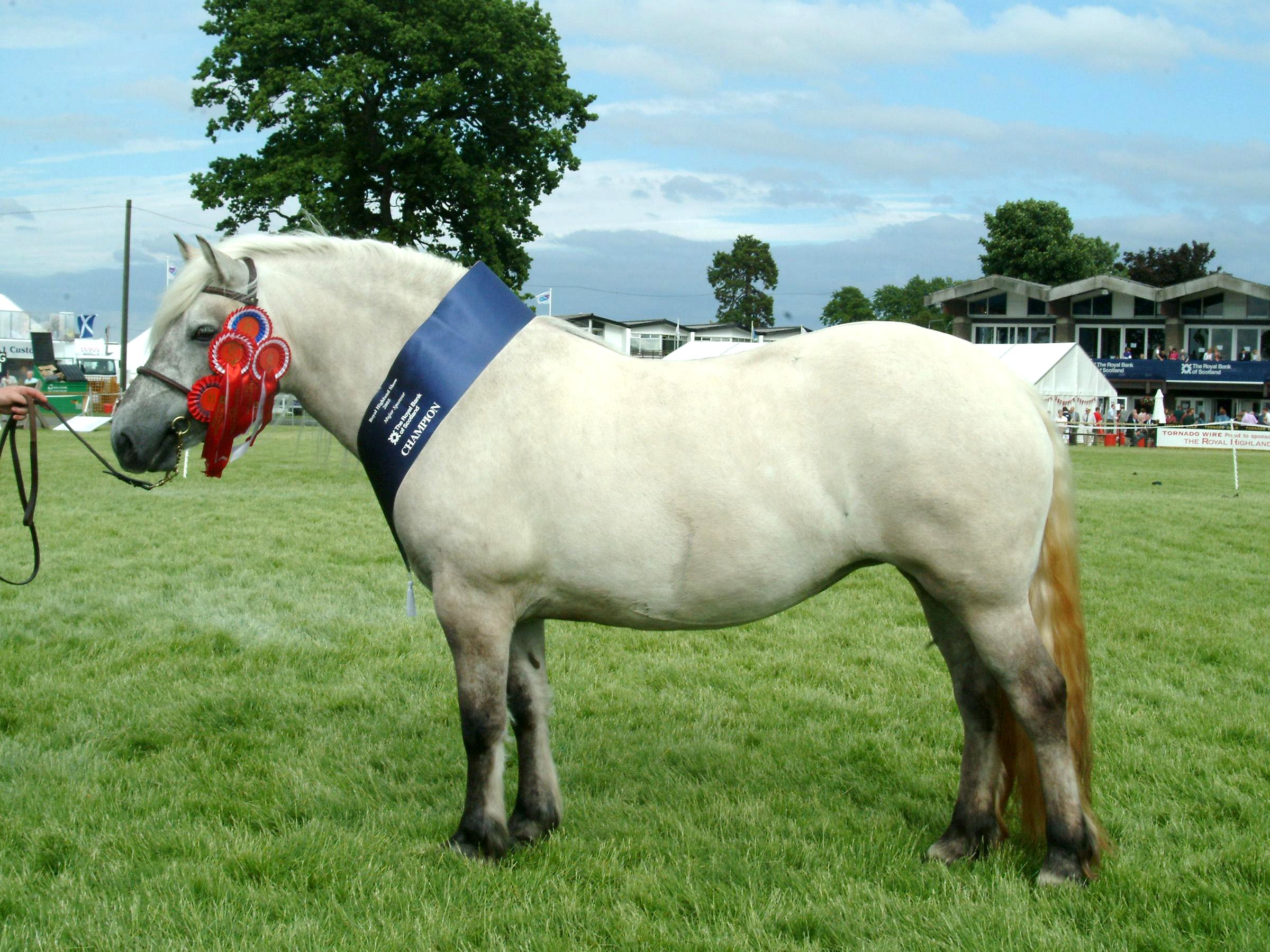|
Animal Stall
An animal stall is an enclosure housing one or a few animals. Stalls for animals can often be found wherever animals are kept: a horse stable is often a purpose-built and permanent structure. A farmer's barn may be subdivided into animal stalls or pens for cows and other livestock. Tie stalls are a type of stall where animals are tethered at the neck to their stall. It is mostly used in the dairy industry, although horses might also be stalled in tie stalls (often referred to as stands or straight stalls). Typical the barn has two rows of stalls, where the cow is tied up for resting, feeding, milking and watering. This type of housing is used in both regular and organic farming. Horse care In horse care, the standard dimensions for a "loose box" (UK) or "box stall" (US) vary from to , depending on local cultural traditions, the breed of horse, gender, and any special needs. Mares with foals often are kept in double stalls. Stallions, kept alone with less access to turnout, are ... [...More Info...] [...Related Items...] OR: [Wikipedia] [Google] [Baidu] |
Polish Stable In Gdansk
Polish may refer to: * Anything from or related to Poland, a country in Europe * Polish language * Poles, people from Poland or of Polish descent * Polish chicken *Polish brothers (Mark Polish and Michael Polish, born 1970), American twin screenwriters Polish may refer to: * Polishing, the process of creating a smooth and shiny surface by rubbing or chemical action ** French polishing, polishing wood to a high gloss finish * Nail polish * Shoe polish * Polish (screenwriting), improving a script in smaller ways than in a rewrite See also * * * Polonaise (other) A polonaise ()) is a stately dance of Polish origin or a piece of music for this dance. Polonaise may also refer to: * Polonaises (Chopin), compositions by Frédéric Chopin ** Polonaise in A-flat major, Op. 53 (french: Polonaise héroïque, lin ... {{Disambiguation, surname Language and nationality disambiguation pages ... [...More Info...] [...Related Items...] OR: [Wikipedia] [Google] [Baidu] |
Foal
A foal is an equine up to one year old; this term is used mainly for horses, but can be used for donkeys. More specific terms are colt for a male foal and filly for a female foal, and are used until the horse is three or four. When the foal is nursing from its dam (mother), it may also be called a "suckling". After it has been weaned from its dam, it may be called a "weanling". When a mare is pregnant, she is said to be "in foal". When the mare gives birth, she is "foaling", and the impending birth is usually stated as "to foal". A newborn horse is "foaled". After a horse is one year old, it is no longer a foal, and is a "yearling". There are no special age-related terms for young horses older than yearlings. When young horses reach breeding maturity, the terms change: a filly over three (four in horse racing) is called a mare, and a colt over three is called a stallion. A castrated male horse is called a gelding regardless of age; however, colloquially, the term "gelding col ... [...More Info...] [...Related Items...] OR: [Wikipedia] [Google] [Baidu] |
Lead (tack)
A lead, lead line, lead rope (US) or head collar rope (UK), is used to lead an animal such as a horse. Usually, it is attached to a halter. The lead may be integral to the halter or, more often, separate. When separate, it is attached to the halter with a heavy clip or snap so that it can be added or removed as needed. A related term, lead shank or lead chain refers to a lead line with a chain attached that is used in a variety of ways to safely control possibly difficult or dangerous horses if they will not respond to a regular lead. Variations A lead can be made from a variety of materials, including cotton, horsehair (woven or braided hair, usually from a horse's tail), leather, nylon or other synthetic materials. Lead ropes, as the name implies, are round and made of various types of rope, usually between 5/8 and 3/4 inch (about 2 cm) in diameter.http://www.sstack.com Halters and leads at Schneider's Saddlery Co. Lead lines are usually flat webbing or le ... [...More Info...] [...Related Items...] OR: [Wikipedia] [Google] [Baidu] |
Manger
__NOTOC__ A manger or trough is a rack for fodder, or a structure or feeder used to hold food for animals. The word comes from the Old French ''mangier'' (meaning "to eat"), from Latin ''mandere'' (meaning "to chew"). Mangers are mostly used in livestock raising and generally found at stables and farmhouses. They are also used to feed wild animals, e.g., in nature reserves. A similar trough providing drinking water for domestic or non-domestic animals is a watering trough and may be part of a larger watering structure called abreuvoir. The manger in Christianity The manger is also associated with nativity scenes where Mary and Joseph, forced by necessity to stay in a room for animals instead of a guest room, used a manger as a makeshift crib for the Baby Jesus. ( el, φάτνη ''phatnē''; Luke 2:7). Gallery File:Devil's_Farmhouse,_Mellieha.jpeg, 18th century limestone mangers at The Devil's Farmhouse in Mellieha, Malta. File:Donkey eating.jpg, Donkey eating apples from ... [...More Info...] [...Related Items...] OR: [Wikipedia] [Google] [Baidu] |
Working Animal
A working animal is an animal, usually domesticated, that is kept by humans and trained to perform tasks instead of being slaughtered to harvest animal products. Some are used for their physical strength (e.g. oxen and draft horses) or for transportation (e.g. riding horses and camels), while others are service animals trained to execute certain specialized tasks (e.g. hunting and guide dogs, messenger pigeons and fishing cormorants). They may also be used for milking or herding. Some, at the end of their working lives, may also be used for meat or other products such as leather. The history of working animals may predate agriculture, with dogs used by our hunter-gatherer ancestors. Around the world, millions of animals work in relationship with their owners. Domesticated species are often bred for different uses and conditions, especially horses and working dogs. Working animals are usually raised on farms, though some are still captured from the wild, such as dolphins and ... [...More Info...] [...Related Items...] OR: [Wikipedia] [Google] [Baidu] |
Draft Horse
A draft horse (US), draught horse (UK) or dray horse (from the Old English ''dragan'' meaning "to draw or haul"; compare Dutch ''dragen'' and German ''tragen'' meaning "to carry" and Danish ''drage'' meaning "to draw" or "to fare"), less often called a carthorse, work horse or heavy horse, is a large horse bred to be a working animal doing hard tasks such as plowing and other farm labor. There are a number of breeds, with varying characteristics, but all share common traits of strength, patience, and a docile temperament which made them indispensable to generations of pre-industrial farmers. Draft horses and draft crossbreds are versatile breeds used today for a multitude of purposes, including farming, draft horse showing, logging, recreation, and other uses. They are also commonly used for crossbreeding, especially to light riding breeds such as the Thoroughbred, for the purpose of creating sport horses of warmblood type. While most draft horses are used for driving, they c ... [...More Info...] [...Related Items...] OR: [Wikipedia] [Google] [Baidu] |
Warmblood
Warmbloods are a group of middle-weight horse types and breeds primarily originating in Europe and registered with organizations that are characterized by open studbook policy, studbook selection, and the aim of breeding for equestrian sport. The term distinguishes these horses from both heavy draft horses ("cold bloods") and refined light saddle horses such as the Thoroughbred, Arabian, and Akhal-Teke ("hot bloods"). Although modern warmbloods are descended from heavier agricultural types systematically upgraded by hotblood influence, the term does not imply that warmbloods are direct crosses of "cold" and "hot". Breeding policies Open studbook policies separate most warmbloods from true "breeds" such as Thoroughbreds, Arabians, Percherons, and Morgans which have a closed stud book and require two purebred parents. Instead, most warmblood registries accept breeding stock from other similar populations to continuously improve their own, and do not consider their own horses ... [...More Info...] [...Related Items...] OR: [Wikipedia] [Google] [Baidu] |
Pony
A pony is a type of small horse ('' Equus ferus caballus''). Depending on the context, a pony may be a horse that is under an approximate or exact height at the withers, or a small horse with a specific conformation and temperament. Compared to a larger horse, a pony may have a thicker coat, mane and tail, with proportionally shorter legs, a wider barrel, heavier bone, a thicker neck and a shorter, broader head. The word ''pony'' derives from the old French ''poulenet'', meaning foal, a young, immature horse. Small horses and ponies were traditionally used for riding, driving and as pack beasts. During the Industrial Revolution, particularly in Great Britain, many were used as pit ponies, hauling loads of coal in the mines. In the modern era they may be kept as children's mounts, for recreational or competitive riding or driving, or for cultural or conservation reasons. Ponies are generally considered intelligent and friendly. They are sometimes also described as stubbor ... [...More Info...] [...Related Items...] OR: [Wikipedia] [Google] [Baidu] |
Stallion
A stallion is a male horse that has not been gelded (castrated). Stallions follow the conformation and phenotype of their breed, but within that standard, the presence of hormones such as testosterone may give stallions a thicker, "cresty" neck, as well as a somewhat more muscular physique as compared to female horses, known as ''mares'', and castrated males, called ''geldings''. Temperament varies widely based on genetics, and training, but because of their instincts as herd animals, they may be prone to aggressive behavior, particularly toward other stallions, and thus require careful management by knowledgeable handlers. However, with proper training and management, stallions are effective equine athletes at the highest levels of many disciplines, including horse racing, horse shows, and international Olympic competition. "Stallion" is also used to refer to males of other equids, including zebras and donkeys. Herd behavior Contrary to popular myths, many stallions do no ... [...More Info...] [...Related Items...] OR: [Wikipedia] [Google] [Baidu] |
Mare
A mare is an adult female horse or other equine. In most cases, a mare is a female horse over the age of three, and a filly is a female horse three and younger. In Thoroughbred horse racing, a mare is defined as a female horse more than four years old. The word can also be used for other female equine animals, particularly mules and zebras, but a female donkey is usually called a "jenny". A broodmare is a mare used for breeding. A horse's female parent is known as its dam. Reproductive cycle Mares carry their young (called foals) for approximately 11 months from conception to birth. (Average range 320–370 days.)Ensminger, M. E. ''Horses and Horsemanship: Animal Agriculture Series.'' Sixth Edition. Interstate Publishers, 1990. p. 156 Usually just one young is born; twins are rare. When a domesticated mare foals, she nurses the foal for at least four to six months before it is weaned, though mares in the wild may allow a foal to nurse for up to a year. The estrous cycle ... [...More Info...] [...Related Items...] OR: [Wikipedia] [Google] [Baidu] |
Checking Out His New Digs
Check or cheque, may refer to: Places * Check, Virginia Arts, entertainment, and media * ''Check'' (film), a 2021 Indian Telugu-language film * ''The Checks'' (episode), a 1996 TV episode of ''Seinfeld'' Games and sports * Check (chess), a threat to capture the king or general * Check (poker), declining to bet * Checking (ice hockey), several techniques * Cross-check, in chess, a check played in reply to a check * Poker chip, less commonly referred to as a check Music * "Check" (Meek Mill song), 2015 * "Check" (Young Thug song), 2015 * "Check", a song by Chris Janson from the album '' Real Friends'' * "Check", a song by E-40 from the album '' The D-Boy Diary: Book 1'' * "Check", a song by Kojo Funds * "Check", a song by Lil Durk from the album ''Lil Durk 2X'' * "Check", a song by Max Webster from the album ''Universal Juveniles'' * "Check", a song by Nas and Rick Ross from the soundtrack to ''Creed II'' * "Check", a song by Quin NFN * "Check", a song by Qveen Herby from the ... [...More Info...] [...Related Items...] OR: [Wikipedia] [Google] [Baidu] |
Horse Care
There are many aspects to horse management. Horses, ponies, mules, donkeys and other domesticated equids require attention from humans for optimal health and long life. Living environment Horses require both shelter from natural elements like wind and precipitation, as well as room to exercise. Worldwide, horses and other equids usually live outside with access to shelter for protection from the elements. In some cases, animals are kept in a barn or stable for ease of access by managers, or for protection from the weather for various reasons. For horse owners who do not own their own land, fields and barns can be rented from a private land owner or space for an individual horse may be rented from a boarding farm. Horses that are not on full-time turnout in a field or pasture normally require some form of regular exercise, whether it is being ridden, longed or turned out for free time. However, if a horse is ill or injured it may need to be confined to a stable, usually in a ... [...More Info...] [...Related Items...] OR: [Wikipedia] [Google] [Baidu] |








_(8536503249).jpg)
